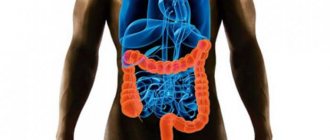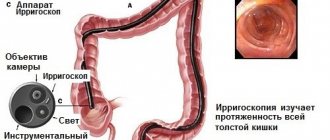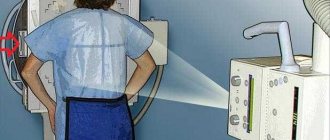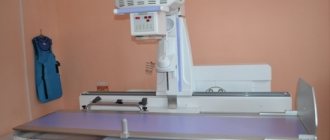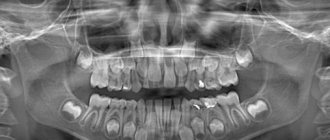One of the effective diagnostic studies of the digestive organs is an X-ray of the intestines (irrigoscopy). The procedure is carried out to determine pathologies of the gastrointestinal tract and visualize features of the gastrointestinal tract that are not determined by other research methods.
Diagnosis is carried out using x-rays. They pass through the human body and are absorbed unevenly by organs. The picture helps to obtain a picture of the digestive organs, which is sent to a radiologist for interpretation.
X-rays are used to examine the gastrointestinal tract, since this procedure is much cheaper than MRI. The distinctive advantages of x-rays of the digestive organs are as follows:
- The diagnosis is non-invasive (without additional incisions), and is not associated with pain or any inconvenience during its implementation;
- X-raying the intestine with barium makes it possible to visualize the contours and see organ abnormalities;
- after an examination with a radiocontrast agent, patients do not have any unpleasant sensations, it is not absorbed into the blood and is excreted naturally;
- new equipment used in diagnostics regulates the intensity of radiation exposure, i.e., it differentiates the radiation dose depending on the patient’s age, his condition, etc.
Indications for the study
Despite the safety of fluoroscopy of the gastrointestinal tract, the study is carried out strictly according to indications when it is impossible to diagnose the pathology by other means.
For example, barium makes it possible to look at the appendix, a problem area of the small intestine that communicates with it and causes appendicitis.
With appendicitis, patients face death, since the disease rapidly worsens a person’s health, and peritonitis begins in a matter of hours. Surgical interventions performed on the first day after the development of the disease are considered effective.
Therefore, a quick X-ray of the small intestine with barium saves the lives of patients with appendicitis and helps to quickly make a diagnosis and carry out urgent surgery.
In addition to urgent x-rays, it is also prescribed for patients who have come in routinely with the following complaints:
- constipation or diarrhea that otherwise complicates examination;
- sudden loss of body weight, emaciation against the background of complaints about the functioning of the digestive system;
- changes in stool characteristics.
Indications for the procedure are:
- suspected obstruction;
- presence or suspicion of tumors, cysts, polyps;
- developmental anomalies;
- diverticula;
- Crohn's disease, ulcerative colitis.
Interpretation of results
The data obtained is deciphered by a specialized specialist - a radiologist. It takes no more than half an hour to obtain the results of the study. Normally, the pictures should have a speckled image.
In the presence of flakes we are talking about the development of:
- lymphosarcoma;
- lymphogranulomatosis;
- malabsorption syndrome.
Polyps
An X-ray examination of the intestines can reveal polyps. The formations are localized on the mucous membrane and do not cause much harm. Despite this, they must be identified and removed, which eliminates the possibility of developing malignant degeneration.
Signs of intestinal obstruction on x-ray
Intestinal obstruction has peculiar symptoms: pain in the abdomen and vomiting. In this case, intestinal motility is also impaired. The x-ray shows small intestinal obstruction in the form of a stop in the movement of contrast agent or air to other parts.
Intestinal dyskinesia
The disorder may be asymptomatic and detected during an x-ray for the first time. Intestinal dyskinesia is accompanied by insufficiency, that is, functional disorders.
X-ray signs of hypomotor dyskinesia include weakened peristalsis and intestinal tone. This is fraught with a slowdown in metabolic processes and contributes to weight gain. The development of intestinal obstruction should be highlighted as complications.
Proper preparation for x-rays
Proper preparation for an x-ray examination is the key to obtaining a reliable result, therefore, before the procedure, doctors focus on what needs to be done first before going for an x-ray. To prepare the patient, the following is recommended:
- a few days before the test, drink at least one and a half liters of water;
- at the indicated time, take laxatives - “Bisacodyl”, “Fortrans”, “Forlax”, “Regulon”;
- exclude “heavy” foods a few days before the x-ray - legumes, flour products, fatty meats, dairy products, mushrooms, i.e., things that cause bloating, constipation or diarrhea;
- do not drink other medications (except for vital prescriptions) or carbonated water during the day;
- Before the examination, give a cleansing enema.
Procedure for barium radiography
The X-ray procedure is quite lengthy; you will need to wait several hours and change positions several times to obtain informative images. The research includes the following stages.
- The patient changes clothes, takes off jewelry, clothes with metal hooks and buttons.
- After this, the person drinks about half a liter of barium mixture in slow sips; if you do this in one gulp, then unpleasant sensations are possible.
- In quiet mode, the patient waits 2-2.5 hours for the contrast agent to reach the intestines.
- After this, the person follows the doctor’s instructions: for 30 minutes, filming takes place in different positions (lying, standing), the dynamic state of the intestine is studied, its patency at different levels.
- The final filming is carried out after bowel movement.
- The study of the relief of the intestinal wall (presence of ulcers, tumor growth) is carried out both in dynamics and on ready-made images.
The patient needs to be prepared for the unpleasant taste of the contrast agent (resembles lime) and a possible feeling of fullness in the abdomen. After completing the procedure, you may experience constipation for several days, so you need to drink enough fluids.
Carrying out a bowel examination
Taking an x-ray is the most critical stage. A patient who has been prepared in advance comes to the clinic at the appointed time. There, the doctor asks several standard questions, asking about your well-being on the eve of an x-ray of the large intestine.
The patient is then required to remove his clothes and put on a disposable shirt. It is important to remember that during an x-ray examination you need to get rid of metal objects on the body, including piercings.
The patient is placed on a couch and a barium solution is introduced into the gastrointestinal tract, which is injected into the rectum. At this moment, the patient experiences discomfort due to a sudden urge to go to the toilet after an x-ray of the rectum, however, these sensations are tolerable and the doctor warns how to behave.
A few minutes after the solution is administered, pictures of the digestive tract are taken, and the patient holds his breath for a while.
If necessary, the medical staff adjusts the patient’s position and turns him on his side to get a picture of the intestines in the desired projection. In modern clinics there are devices that move on their own and take pictures without disturbing the patient.
After a series of images, the tube is removed from the anus, and the X-ray of the intestines is considered completed, and the patient can get dressed.
After the study, patients are asked to visit the toilet, since for some barium does not stay in the body for long, but for other patients it threatens constipation. There is no need to be afraid of this. If barium was given for an x-ray of the intestines, the consequences can easily be eliminated with laxatives.
Types of X-ray examination
Methods for examining the intestines using X-rays are divided into
- non-contrasting and
- carried out using radiopaque agents.
Fluoroscopy and abdominal radiography are non-contrast methods.
They allow you to detect
- free gas in the abdominal cavity due to perforation of the intestinal wall,
- foreign bodies,
- pathological accumulations of fluid and gas in the intestine due to its obstruction, etc.
What will an x-ray show?
Based on the results of intestinal radiography, it is possible to establish:
- presence of obstruction;
- pathology of the appendix;
- diverticula, pathological volvulus and torsion;
- places of abnormal narrowing or expansion of the intestine;
- tumor neoplasms;
- defects in intestinal filling.
Depending on what the intestinal x-ray shows, doctors prescribe additional tests - biopsy, colonoscopy, CT. X-ray examination, along with other signs, serves as an indication for surgical intervention.
Contraindications
Despite the apparent simplicity and safety of the study, intestinal fluoroscopy also has contraindications. The examination is not carried out if the patient is suspected of gastric bleeding, since in case of mechanical damage that provoked hemorrhage, the use of X-rays with contrast can be dangerous.
X-rays are not taken in case of severe spastic pain, since the patient will not be able to lie quietly and motionless, and when moving, the study is not informative. The procedure is refused if a gastric ulcer is suspected, and is also not performed on patients who have recently undergone a biopsy procedure. X-rays are contraindicated for women during pregnancy.
general information
X-ray is the most popular method of conducting examinations of the large intestine, due to its low cost and sufficient information content. The study represents the direction of X-rays using a special device into the human body. They do not cause discomfort and are absolutely harmless. Each organ reflects radiation in its own way and thanks to this feature it is possible to obtain an image. The resulting image is examined by a radiologist and passed on to the attending physician. Another diagnostic method based on the use of X-rays is called fluoroscopy. It allows you to monitor your intestinal health in real time. X-ray examinations can also be performed with a contrast agent. Barium is used as it. It is not absorbed into the blood, so it does not cause allergic reactions in humans.
Price
Prices for research depend on various indicators, including the region. For example, in Moscow clinics a study will cost two thousand rubles, but in Novosibirsk on average about a thousand.
An x-ray of the colon with double contrast in Moscow will cost about seven thousand rubles, and in other cities it will cost almost half as much. To determine the price category of the study, you can compare clinics in the same region and take into account the equipment used for diagnostics.
X-ray diagnostics of the intestines is an effective procedure with which you can see pathologies in the development and functioning of the digestive organs.
It is extremely important in urgent conditions of the patient, when the issue of surgical intervention is being decided. It is performed on patients of all ages, even children with suspected congenital intestinal anomalies.
Reviews
Patient reviews regarding the procedure are in most cases positive. Clinics and diagnostic centers treat such patients with care and help them undergo the procedure without unnecessary stress. For example, you can read a few reviews:
Ekaterina, 39 years old: “I had an X-ray last year, the impressions were positive, the staff helped during the procedure. I did the research at a specialized diagnostic center at the clinic.”
Igor, 54 years old: “The doctors suspected I had an obstruction, since all the signs pointed to it. They performed an x-ray - the procedure was not pleasant, but tolerable. The main thing is that the diagnosis was confirmed and the operation was carried out in a timely manner.”
Oleg Ivanovich, 65 years old: “I was sent for an X-ray of the intestines on suspicion of a malignant tumor. The X-ray did not take long, competent staff worked with me and everything went well, although I was worried. As a result, the diagnosis was not confirmed in the image, which was later shown by a colonoscopy.”
